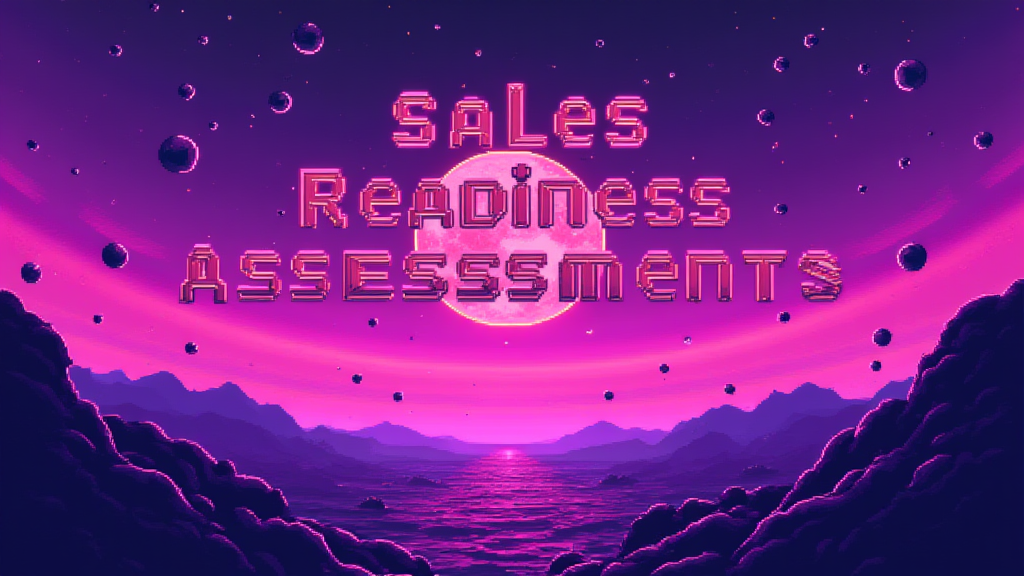Sales Readiness Assessments: Boosting Team Performance

Published on: October 01, 2024
Sales Readiness Assessments are strategic evaluations designed to measure and enhance the preparedness of a sales team to effectively engage with prospects and close deals. These comprehensive assessments play a crucial role in identifying strengths, weaknesses, and areas for improvement within a sales organization. 📊
Why Sales Readiness Assessments Matter
In today's competitive business landscape, having a well-prepared sales team is essential for driving revenue growth. Sales Readiness Assessments provide valuable insights that enable organizations to:
- Identify skill gaps and training needs
- Align sales strategies with company goals
- Improve sales performance and productivity
- Enhance customer engagement and satisfaction
- Reduce onboarding time for new sales representatives
Key Components of Sales Readiness Assessments
A comprehensive Sales Readiness Assessment typically includes the following components:
1. Product Knowledge 📚
Evaluating sales representatives' understanding of product features, benefits, and unique selling propositions.
2. Sales Process Proficiency 🔄
Assessing familiarity with the company's sales methodology and ability to navigate each stage of the sales cycle.
3. Communication Skills 🗣️
Measuring the effectiveness of verbal and written communication, including active listening and objection handling.
4. Technology Proficiency 💻
Evaluating the ability to use CRM systems, sales enablement tools, and other relevant technologies.
5. Industry Knowledge 🌐
Assessing understanding of market trends, competitor landscapes, and customer pain points.
Implementing Sales Readiness Assessments
To effectively implement Sales Readiness Assessments, organizations should follow these best practices:
- Set Clear Objectives: Define specific goals for the assessment process.
- Choose Appropriate Assessment Methods: Utilize a mix of quizzes, role-playing exercises, and simulations.
- Establish Benchmarks: Create performance standards based on top-performing sales representatives.
- Provide Timely Feedback: Offer constructive feedback and actionable insights to sales team members.
- Develop Personalized Training Plans: Create tailored learning paths based on assessment results.
Benefits of Regular Sales Readiness Assessments
Conducting regular Sales Readiness Assessments can yield significant benefits for organizations:
| Benefit | Impact |
|---|---|
| Improved Win Rates | Up to 15% increase in sales conversions |
| Reduced Ramp-up Time | 25-30% faster onboarding for new hires |
| Enhanced Customer Satisfaction | 10-20% improvement in customer retention |
| Increased Revenue | 5-10% growth in overall sales performance |
Overcoming Common Challenges
While implementing Sales Readiness Assessments, organizations may face several challenges:
- Resistance to Change: Address concerns through clear communication and highlighting benefits.
- Time Constraints: Integrate assessments into existing workflows and utilize microlearning approaches.
- Data Overload: Focus on key metrics and actionable insights to avoid overwhelming teams.
- Maintaining Consistency: Establish a regular assessment schedule and standardize evaluation criteria.
The Future of Sales Readiness Assessments
As technology continues to evolve, Sales Readiness Assessments are likely to incorporate more advanced features:
- AI-powered performance analysis
- Virtual reality simulations for realistic sales scenarios
- Predictive analytics to forecast sales readiness
- Gamification elements to increase engagement
By embracing these innovations, organizations can stay ahead of the curve and ensure their sales teams are always prepared for success. 🚀
Implementing Sales Readiness Assessments in Your Organization
To effectively implement Sales Readiness Assessments in your organization, consider asking yourself the following questions:
- What are our current sales performance gaps?
- How can we align our assessment criteria with our sales goals?
- What tools and technologies can we leverage to streamline the assessment process?
- How can we create a culture of continuous improvement through regular assessments?
- What metrics should we track to measure the impact of our Sales Readiness Assessments?
By addressing these questions, you'll be well-equipped to develop a robust Sales Readiness Assessment strategy that drives your team's performance and boosts your bottom line. 💪

















